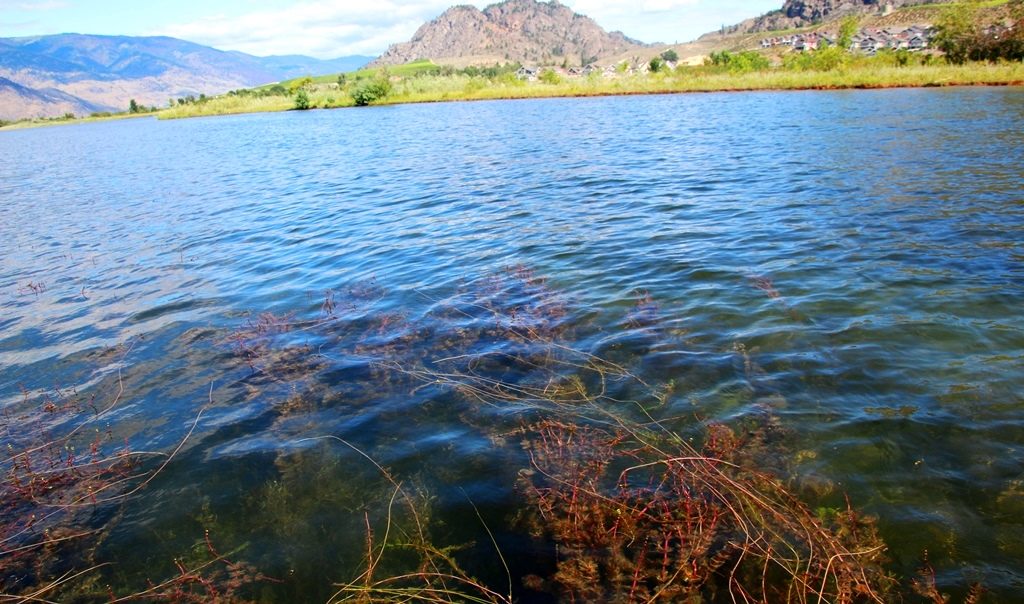Eurasian Milfoil – Aquatic Weed
Beautiful but Deadly

Eurasian Milfoil bed in full bloom at north end of Osoyoos Lake. Photo Credit: Neil Bousquet
Eurasian watermilfoil is an attractive plant with feathery underwater foliage. It was once commonly sold as an aquarium plant, and was first discovered in Osoyoos Lake in 1975.
Studies in the U.S. have shown clearly that Eurasian Milfoil has been spread from lake to lake on boat trailers. It is a major problem in water bodies all over the North American continent.
Growth Habit
Because it is widely distributed and difficult to control, milfoil is considered to be the most problematic plant in Osoyoos Lake. The introduction of milfoil can drastically alter a waterbody’s ecology.
Milfoil forms very dense mats on the surface of the water. For humans, these mats interfere with recreational activities such as swimming, fishing, water skiing and boating.
The sheer mass of plants can cause flooding and the stagnant mats create good habitat for mosquitoes. Milfoil mats can rob oxygen from the water by preventing the wind from mixing the oxygenated surface waters to deeper water. The dense mats of vegetation can increase the sedimentation rate by trapping sediments.
Milfoil also starts spring growth sooner than native aquatic plants and can shade out these beneficial plants. When milfoil invades new territory, typically the species diversity of aquatic plants declines. While some waterfowl will eat milfoil, it is not considered to be a good food source.
Milfoil reproduces extremely rapidly and can infest an entire lake within two years of introduction to the system.
A single wisp can turn into 250 million new plants within one year.
In the late summer and fall the plants become brittle and naturally break apart. These fragments will float to other areas, sink, and start new plants. Milfoil will also grow from fragments created by boaters or other disturbances during any time of year. This is why milfoil can so easily be transported from lake to lake on boat trailers or fishing gear.
Management
Experts throughout North America are working to find an effective way to control this weed. Once milfoil becomes well-established it is difficult or impossible to remove .
 Recently the Washington State legislature gave limited approval for the use of the herbicide 2,4-D to control pioneering milfoil infestations. Although this product is the most widely used herbicide in the world, it is banned in Canada. Other control methods include: harvesting, rotovation (underwater rototilling), installation of bottom barriers, diver hand pulling, diver dredging, and in some very limited situations the use of triploid (sterile) grass carp. Other biological control such as the milfoil weevil are also being investigated.
Recently the Washington State legislature gave limited approval for the use of the herbicide 2,4-D to control pioneering milfoil infestations. Although this product is the most widely used herbicide in the world, it is banned in Canada. Other control methods include: harvesting, rotovation (underwater rototilling), installation of bottom barriers, diver hand pulling, diver dredging, and in some very limited situations the use of triploid (sterile) grass carp. Other biological control such as the milfoil weevil are also being investigated.
In Osoyoos Lake, a milfoil harvester (left) employed by the Okanagan Basin Water Board can be seen each spring cutting the stems of the weeds.
What you can do
Remove all weeds – even small fragments – from your boat, trailer, fishing gear etc. whenever you leave the water.
If you own lakeshore property, rake up the milfoil from your beach as often as you can.
Makes great fertilizer!
On the plus side, did you know that milfoil makes excellent compost for your garden? Rake it into a pile, keep it moist and let it decompose naturally for about a year, then mix it with the soil.







